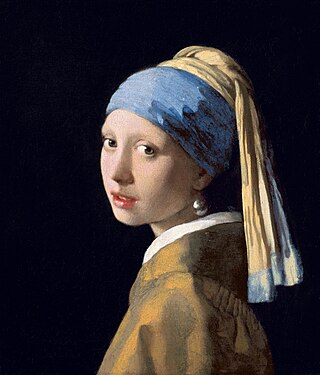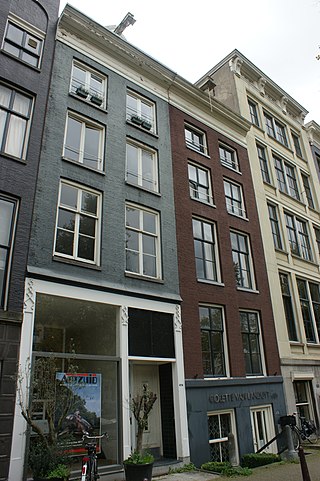
The history of painting reaches back in time to artifacts and artwork created by pre-historic artists, and spans all cultures. It represents a continuous, though periodically disrupted, tradition from Antiquity. Across cultures, continents, and millennia, the history of painting consists of an ongoing river of creativity that continues into the 21st century. Until the early 20th century it relied primarily on representational, religious and classical motifs, after which time more purely abstract and conceptual approaches gained favor.

Modernism is an early 20th-century movement in literature, visual arts, and music that emphasized experimentation, abstraction, and subjective experience. Philosophy, politics, architecture, urban planning, and social issues were also aspects of the movement, which sought to change how "human beings in a society interact and live together".
Abstract expressionism in the United States emerged as a distinct art movement in the immediate aftermath of World War II and gained mainstream acceptance in the 1950s, a shift from the American social realism of the 1930s influenced by the Great Depression and Mexican muralists. The term was first applied to American art in 1946 by the art critic Robert Coates. Key figures in the New York School, which was the epicenter of this movement, included such artists as Arshile Gorky, Jackson Pollock, Franz Kline, Mark Rothko, Norman Lewis, Willem de Kooning, Adolph Gottlieb, Clyfford Still, Robert Motherwell and Theodoros Stamos among others.

Modern art includes artistic work produced during the period extending roughly from the 1860s to the 1970s, and denotes the styles and philosophies of the art produced during that era. The term is usually associated with art in which the traditions of the past have been thrown aside in a spirit of experimentation. Modern artists experimented with new ways of seeing and with fresh ideas about the nature of materials and functions of art. A tendency away from the narrative, which was characteristic of the traditional arts, toward abstraction is characteristic of much modern art. More recent artistic production is often called contemporary art or Postmodern art.

Visual art of the United States or American art is visual art made in the United States or by U.S. artists. Before colonization, there were many flourishing traditions of Native American art, and where the Spanish colonized Spanish Colonial architecture and the accompanying styles in other media were quickly in place. Early colonial art on the East Coast initially relied on artists from Europe, with John White the earliest example. In the late 18th and early 19th centuries, artists primarily painted portraits, and some landscapes in a style based mainly on English painting. Furniture-makers imitating English styles and similar craftsmen were also established in the major cities, but in the English colonies, locally made pottery remained resolutely utilitarian until the 19th century, with fancy products imported.

Lenore "Lee" Krasner was an American painter and visual artist active primarily in New York whose work has been associated with the Abstract Expressionist movement. She received her early academic training at the Women's Art School of Cooper Union, and the National Academy of Design from 1928 to 1932. Krasner's exposure to Post-Impressionism at the newly opened Museum of Modern Art in 1929 led to a sustained interest in modern art. In 1937, she enrolled in classes taught by Hans Hofmann, which led her to integrate influences of Cubism into her paintings. During the Great Depression, Krasner joined the Works Progress Administration's Federal Art Project, transitioning to war propaganda artworks during the War Services era.
Post-expressionism is a term coined by the German art critic Franz Roh to describe a variety of movements in the post-war art world which were influenced by expressionism but defined themselves through rejecting its aesthetic. Roh first used the term in an essay in 1925, "Magic Realism: Post-Expressionism", to contrast to Gustav Friedrich Hartlaub's "New Objectivity", which more narrowly characterized these developments within German art. Though Roh saw "post-expressionism" and "magic realism" as synonymous, later critics characterized distinctions between magic realism and other artists initially identified by Hartlaub and have also pointed out other artists in Europe who had different stylistic tendencies but were working within the same trend.

The New Objectivity was a movement in German art that arose during the 1920s as a reaction against expressionism. The term was coined by Gustav Friedrich Hartlaub, the director of the Kunsthalle in Mannheim, who used it as the title of an art exhibition staged in 1925 to showcase artists who were working in a post-expressionist spirit. As these artists—who included Max Beckmann, Otto Dix, George Grosz, Christian Schad, Rudolf Schlichter and Jeanne Mammen—rejected the self-involvement and romantic longings of the expressionists, Weimar intellectuals in general made a call to arms for public collaboration, engagement, and rejection of romantic idealism.
Neo-expressionism is a style of late modernist or early-postmodern painting and sculpture that emerged in the late 1970s. Neo-expressionists were sometimes called Transavantgarde, Junge Wilde or Neue Wilden. It is characterized by intense subjectivity and rough handling of materials.
The Bay Area Figurative Movement was a mid-20th-century art movement made up of a group of artists in the San Francisco Bay Area who abandoned working in the prevailing style of Abstract Expressionism in favor of a return to figuration in painting during the 1950s and onward into the 1960s.
Figuration Libre is a French art movement which began in the 1980s. It is the French equivalent of Bad Painting and Neo-expressionism in America and Europe, Junge Wilde in Germany and Transvanguardia in Italy. Artists in the movement typically incorporate elements of comic book art and graffiti into their work. They use bright colors and exaggerated, caricature-like figures.

The history of Western painting represents a continuous, though disrupted, tradition from antiquity until the present time. Until the mid-19th century it was primarily concerned with representational and traditional modes of production, after which time more modern, abstract and conceptual forms gained favor.
In the visual arts, late modernism encompasses the overall production of most recent art made between the aftermath of World War II and the early years of the 21st century. The terminology often points to similarities between late modernism and postmodernism, although there are differences. The predominant term for art produced since the 1950s is contemporary art. Not all art labelled as contemporary art is modernist or post-modern, and the broader term encompasses both artists who continue to work in modern and late modernist traditions, as well as artists who reject modernism for post-modernism or other reasons. Arthur Danto argues explicitly in After the End of Art that contemporaneity was the broader term, and that postmodern objects represent a subsector of the contemporary movement which replaced modernity and modernism, while other notable critics: Hilton Kramer, Robert C. Morgan, Kirk Varnedoe, Jean-François Lyotard and others have argued that postmodern objects are at best relative to modernist works.

20th-century Western painting begins with the heritage of late-19th-century painters Vincent van Gogh, Paul Cézanne, Paul Gauguin, Georges Seurat, Henri de Toulouse-Lautrec, and others who were essential for the development of modern art. At the beginning of the 20th century, Henri Matisse and several other young artists including the pre-cubist Georges Braque, André Derain, Raoul Dufy and Maurice de Vlaminck, revolutionized the Paris art world with "wild", multi-colored, expressive landscapes and figure paintings that the critics called Fauvism. Matisse's second version of The Dance signified a key point in his career and in the development of modern painting. It reflected Matisse's incipient fascination with primitive art: the intense warm color of the figures against the cool blue-green background and the rhythmical succession of the dancing nudes convey the feelings of emotional liberation and hedonism.

American Figurative Expressionism is a 20th-century visual art style or movement that first took hold in Boston, and later spread throughout the United States. Critics dating back to the origins of Expressionism have often found it hard to define. One description, however, classifies it as a Humanist philosophy, since it is human-centered and rationalist. Its formal approach to the handling of paint and space is often considered a defining feature, too, as is its radical, rather than reactionary, commitment to the figure.

Minimalism describes movements in various forms of art and design, especially Visual art and music, where the work is set out to expose the essence, essentials or identity of a subject through eliminating all non-essential forms, features or concepts. As a specific movement in the arts it is identified with developments in post–World War II Western Art, most strongly with American visual arts in the 1960s and early 1970s. Minimalism is often interpreted as a reaction to abstract expressionism and a bridge to postminimal art practices. Prominent artists associated with this movement include Ad Reinhardt, Nassos Daphnis, Tony Smith, Donald Judd, John McCracken, Agnes Martin, Dan Flavin, Robert Morris, Larry Bell, Anne Truitt, Yves Klein and Frank Stella. Artists themselves have sometimes reacted against the label due to the negative implication of the work being simplistic.

Woman VI is a 1953 abstract work of art painted by Willem de Kooning and first displayed at the Sidney Janis Gallery in Manhattan. Since the 1955 Carnegie International Exhibition, Woman VI has been on view at the Carnegie Museum of Art as part of the Postwar Abstraction collection. The Woman paintings of the early 1950s are widely considered to be de Kooning’s most important works for their significance to postwar American cultural history and social events, such as the mid-century Feminist Movements. Many of the paintings are speculated to be abstracted portraits of Marilyn Monroe. Woman VI is notable within the series for its brighter palette of green and red paint employed in larger fields of color.
Boston Expressionism is an arts movement marked by emotional directness, dark humor, social and spiritual themes, and a tendency toward figuration strong enough that Boston Figurative Expressionism is sometimes used as an alternate term to distinguish it from abstract expressionism, with which it overlapped.
Nueva Figuración was an artistic movement in Spain and Latin America, specifically Argentina, Mexico, and Venezuela, that embraced a new form of figurative art in response to both abstraction and traditional forms of representation. Artists advocated a return to the human figure and everyday reality. They also rejected the aestheticized forms of traditional art, employing informal techniques, expressionism, and collage.

Galley Swart is a former Dutch gallery of Riekje Swart in Amsterdam from 1964 to 2000. The gallery promoted contemporary art of varies young art movements, and primarily wanted to arise interest for modern art.











